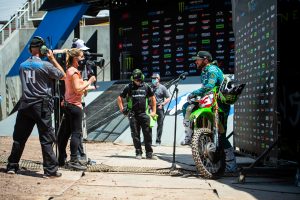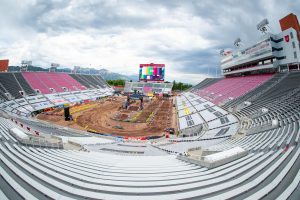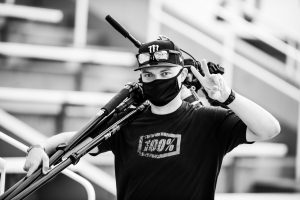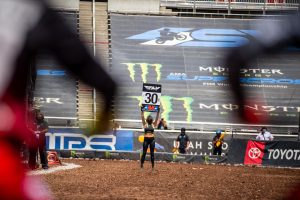Feld Entertainment Brings Back Monster Energy AMA Supercross With Focus on Crew Safety
NBC Sports’ production partner stringently followed CDC guidelines
Story Highlights
As U.S. sports make a gradual comeback from the depths of the coronavirus, motorsports is leading the return to live event production. Along with MotoAmerica Superbike, NBC Sports’ presentation of Monster Energy AMA Supercross returned this past Sunday in Salt Lake City’s Rice-Eccles Stadium. For Feld Entertainment, the network’s production partner, putting on a great broadcast was an objective, but the well-being of all onsite crew members was of utmost importance.
“It’s a new environment and a new challenge for all of us,” says Dave Prater, senior director, operations, two wheel, Feld Entertainment, “but our Supercross group within Feld Entertainment was really cooperative. The organization of everyone from the [Utah] governor’s office and the state and local health departments to the race teams and athletes went really well.”
The Necessary Steps: Testing, Temperature Checks 48 Hours Before Race Day
To establish a safe environment, Prater and his team deemed it necessary to establish a health infrastructure with thorough testing prior to the day of the race.
“Our plan was entailed within two documents that were sent to everyone involved,” he says. “All of the race teams, athletes, and staff signed a health and safety commitment that you were committing to follow; the other [document] was a health questionnaire. Once they arrived in Utah, everyone was tested for COVID-19, waited 48 hours for the results, and then we got to work.”

Like Feld Entertainment, NBC Sports practiced social distancing with post-race interviews conducted from 6 ft. away.
With nearly 700 credentialed personnel for last weekend’s effort, which is about 50% of the crew for a normal event, these procedures ensured that the health of all involved wouldn’t be compromised. After the initial testing phase, medical examinations and temperature checks continued to be administered.
“We set up a secure perimeter around the pits as well as the stadium, and, when you entered the perimeter every day, your temperature was taken,” says Prater. “A face mask was required at all times. We let everybody know and said, ‘Look, there’s obviously going to be less people, so you’re going to be asked to, in some cases, play multiple roles,’ and everybody pulled together.”
Proceed With Caution: Onsite Protocols Include Distancing, Sanitization Equipment
Inside the home of football at the University of Utah, athletes zoomed across a dirt surface with reckless abandon, but, in the compound, the production crew were mindful of each other and followed and enforced CDC guidelines. Within NEP’s onsite mobile units, the crew made sure to adhere to social-distancing regulations by leaving ample space between designated areas.

With no fans at the University of Utah’s Rice-Eccles Stadium for initial races, Feld Entertainment may install an aerial camera system for upcoming races.
In addition, cross-contamination between crews was prevented by a race-day policy.
“We broke down into functional groups because we tried to limit exposure to [our crew],” Prater explains. “We had three different groups in three separate mobile units, and they [weren’t able to] associate with the other units or the groups. They stayed as far apart as they could from each other. [That] helped in the social-distancing portion but made things more challenging to do multiple roles.”
In addition to increased space for each employee, all crew members were required to wear personal protective equipment in the form of a mask, and hand-sanitization stations were scattered around the compound.
“We were just following the federal and state guidelines to a T,” Prater adds. “I think [our onsite team] gets it since everyone has lived through this for the past couple of months. They all want to finish the Supercross season.”
A Template for Future Efforts: The Series’ Final Six Races Ahead
On Sunday, Prater deployed a 12-camera show, fewer than the typical 19, for the first live competition since March 7 in Daytona Beach, FL. Despite having to cut a few camera positions, he is thinking of implementing additional technology to enhance subsequent broadcasts even without fans in the stands.
“We tried to shoot within the stadium walls as best we could, but it was almost impossible to eliminate the sight of empty seats,” he says. “We aren’t allowed to do anything different on Sunday, but we’re looking to install an [aerial] camera system, which wouldn’t be easy to do with people in the stands. That will give us another look.”
Although Feld Entertainment’s camera complement may change, Prater is committed to maintaining an atmosphere that prioritizes safety.
“We have six more events, or about 2½ weeks, left, and we’ll do exactly the same thing that we did for the first one,” he notes. “We don’t plan on changing anything. But everyone came in Monday morning with a smile, so, even though [our crew] knows this is a different situation, they’re embracing it and going forward with a positive attitude.”
Monster Energy AMA Supercross rolls on with Round 12 action on Wednesday, June 3 from Rice-Eccles Stadium in Salt Lake City. Coverage begins with qualifying at 7:30 p.m. ET on NBC Sports Gold and continues with gate drop from 10 p.m. to 1 a.m. on NBC Sports Network.


